Fix: System Restore Failure with Error 0x81000203
You may be having issues with system restore refusing to work in Windows 10 or other Windows versions. This error occurs when trying to do a system restore and ends with stalls with error code 0x81000203. The System Restore utility is an essential part of the Windows system which helps you to roll back on files, applications and settings causing your system to malfunction.
This error is caused when Windows users with TuneUp Utilities 2009 / 2010 / 2011 have the “Turbo Mode” turned on – TuneUp Utilities itself has been the reason for several Windows Errors. Additionally, this issue is caused when Microsoft Software Shadow Copy Provider is disabled or not running and when System Restore is disabled.
To fix this error, we’ll be uninstalling TuneUp Utilities or turning Turbo Mode off, activating Microsoft Software Shadow Copy Provider, and enabling System Restore from the Group Policy and registry. If you don’t have TuneUp Utilities installed, move directly to the second and subsequent methods of this article.
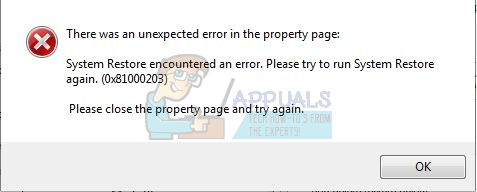
Method 1: Uninstalling TuneUp Utilities/Disabling Turbo Mode
- Launch the Programs and Features window by Holding Windows Key + R to open Run Dialog, then type appwiz.cpl and click OK.

- Look for TuneUp Utilities (and it’s related programs) and double click it. The uninstaller will launch and then go through the prompts to complete the uninstallation. Restart once it’s complete and try performing a restore.
- Try performing a System Restore again and the problem shouldn’t appear this time (and the System Protection Tab should appear).
Turning off Turbo Mode
Turbo Mode disables a service or component responsible for system restore. If you want to keep TuneUp, you can as well turn off the Turbo Mode to use System Restore.
- Open the TuneUp Utilities Start Center
- At the bottom left of the Window you’ll find the “PC Optimization Mode” area. Select “Economy” or “Standard”. You can also click on the small wrench icon below “Turbo” and disable the options under the option.
- Try performing a System Restore again and the problem shouldn’t appear this time.
On other versions of TuneUp utilities, you can click on the Turbo icon at the bottom left of the Window to toggle it off.
Method 2: Turning on Microsoft Software Shadow Copy Provider Service
If TuneUp (or other tuning utilities) are not been installed on your system, it’s possible Microsoft Software Shadow Copy Provider service isn’t running. Here’s how to get the service active.
- Open the Start Menu and type “services”. Right-click on it and “Run as administrator”. You can also do this by pressing Windows Key + R for the Run prompt, typing “services.msc” and pressing Enter.
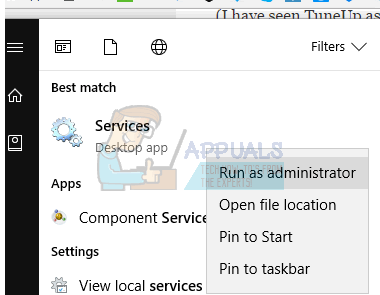
- Search for the service “Microsoft Software Shadow Copy Provider” and double-click it.
- Set the Start type to “Automatic” and click Start to start the service.
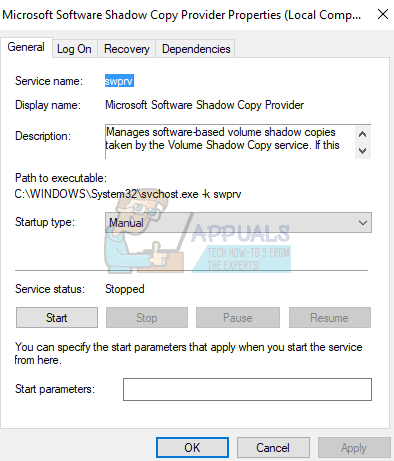
- Open the Control Panel and navigate to System and Security > System Protection and then select the drive, click the Configuration button, and set the Maximum Disk Space usage to something more than zero (depending on the number of restore points you want). Remember to Turn on System Protection from here is you haven’t.
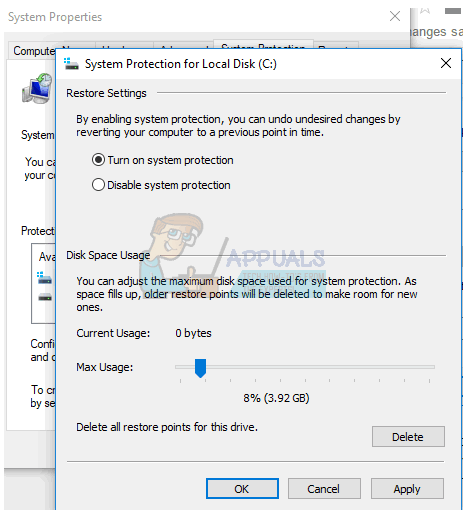
- Click OK, restart the computer and check again for the issue.
If you’re still having issues in starting this service, it’s possible a system policy prevents this launch. The next methods provide a work around for this.
Method 3: Enabling System Restore From the Group Policy Editor
This method works for Windows Pro/Enterprise editions, because Windows Home doesn’t have gpedit.msc.
- Press Windows Key + R, type “gpedit.msc” and press Enter. This opens the Group Policy Editor console.
- Navigate to Navigate to Computer Configuration > Administrative Template > System > System Restore.
- Double-click on “Turn off System Restore” and select “Not Configured”.
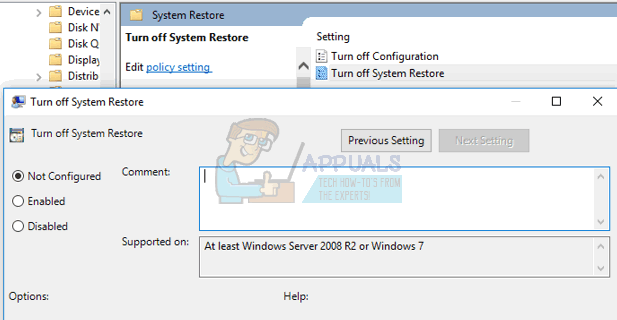
- Restart your PC and system restore should work.
Method 4: Using the Registry
If you’re using a Home Edition, gpedit.msc wouldn’t work for you, so try the following steps using the Registry Editor.
- Press Windows Key + R for the run prompt and type “regedit.exe” and then click OK. If you’re prompted by the UAC, accept it.
- Navigate to HKEY_LOCAL_MACHINE\SOFTWARE\Policies\Microsoft\Windows NT and look for the subentry named “SystemRestore”. If it exists (you can create a new subentry if you wish), check whether the subkey contains the DWORD value DisableConfig.If that value is present and set to 1, it means System Restore is blocked. Either delete DisableConfig or edit and set it to 0.
- Restart your PC and trying using system restore again.
Method 5: Checking the UpperFilters Parameter
UpperFilter values exist in different registry classes and if they are configured incorrectly it can cause an issue during the restore process. Therefore, in this step, we will be checking to see if they are entered properly. For that:
- Press “Windows” + “R” to open Run prompt.
- Type in “regedit” and press “Enter“.
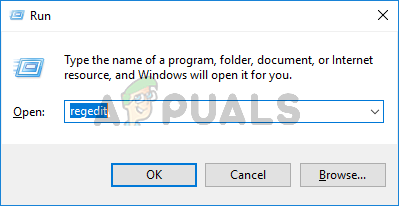
Typing Regedit in Run to Open Registry Editor - Navigate to the following address inside the registry
Computer\HKEY_LOCAL_MACHINE\SYSTEM\CurrentControlSet\Control\Class\{71a27cdd-812a-11d0-bec7-08002be2092f} - In the right pane, check to see if “volsnap” value is entered for the “UpperFilters” entry.

Checking the “Volsnap” value for the UpperFIlters entry - If not, double click on the “UpperFilters” entry and enter “volsnap” in the Value Data option.
- Click on “OK” and check to see if the issue persists.